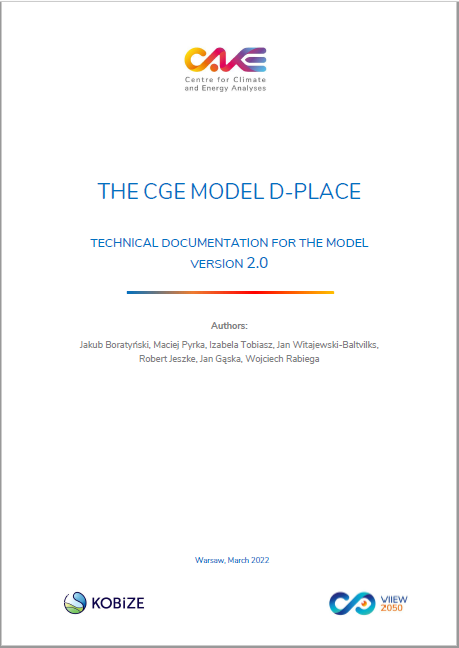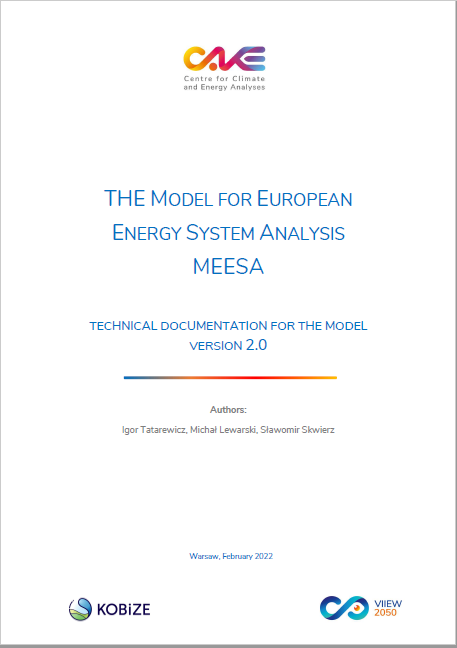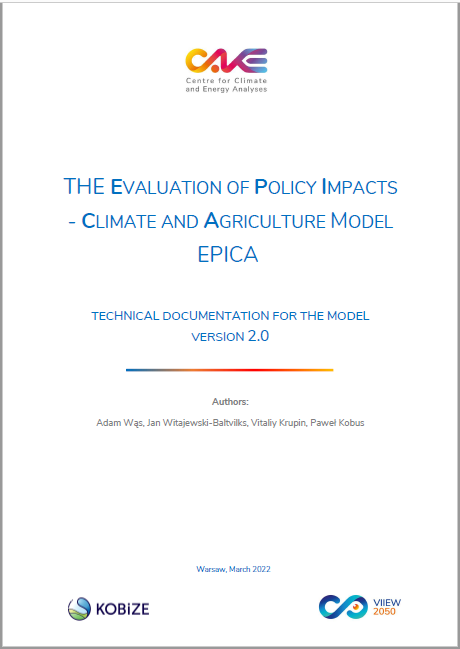New technical documentation updates for CGE model (d-PLACE), energy model (MEESA), transport model (TR3E) and agriculture model (EPICA) – related to the implementation of LIFE VIIEW 2050 project
We are pleased to present the technical documentation updates of the analytical toolkit built within the LIFE Climate CAKE PL project: CGE model (d-PLACE), energy model (MEESA), transport model (TR3E) and agriculture model (EPICA). The development of the models is part of the tasks related to the implementation of new the LIFE VIIEW 2050 project. On the basis of the analytical work undertaken, we are planning to prepare analyses which would respond for the current information needs related to the implementation of climate policy in the EU. The main goal of the LIFE VIIEW 2050 project is to assess and evaluate the operation of the EU ETS, including the extension of its scope to new sectors. New analyses would also focus on the assessment of other elements of the EU climate and energy policy. In order to meet this task, it was necessary to develop and prepare the extension of the models used by the CAKE team.

d-PLACE model is based on the static CGE model called PLACE, which was created in 2013-2016 by members of the Climate Policy Analysis Center (Polish acronym – CAK) cooperating with the Ministry of Economy, the Ministry of the Environment and the Ministry of Finance of the Republic of Poland and experts of the World Bank in cooperation with IOŚ – PIB. d-PLACE model is a recursive dynamic model worldwide and multisectoral. Compared to the first version of the documentation, the model has been expanded with energy technologies, including emission reduction options (eg. CCS / CCU, hydrogen, electric transport) and modeling the costs of transition in the labor market.
The documentation is available below:
 The CGE Model D-PLACE. Technical documentation for the model version 2.0 (2.4 MiB, 931 hits)
The CGE Model D-PLACE. Technical documentation for the model version 2.0 (2.4 MiB, 931 hits)

MEESA energy model (Model for European Energy System Analysis) is a linear model optimizing the coverage of electricity, district heating and hydrogen from electrolysis demand in the EU27 (plus Norway, Switzerland and UK) specializing in balancing emissions. The analytical tool was designed to thoroughly analyze the role of existing and future energy technologies in achieving the goals set by the energy sector in EU climate and energy policy. The model minimizes the total discounted costs of covering the demand for electricity and network heat in the entire analysis period covering 2020-2055 period. For this, MEESA uses over 50 technologies that it can use in each of the 18 (or 72 in the extended version of the model) load zones considered for each year of analysis. Compared to the first version of the documentation, the model has been expanded to include the production of green hydrogen and the possibility of using hydrogen in new gas fired power plant and CHP and in the transport and industry sectors.
The documentation is available below:
 The Model for European Energy System Analysis MEESA. Technical documentation for the model version 2.0 (1.6 MiB, 848 hits)
The Model for European Energy System Analysis MEESA. Technical documentation for the model version 2.0 (1.6 MiB, 848 hits)
 TR3E transport model (Transport European Economic Model) is based on the concept of partial equilibrium. TR3E model consist of two main modules: passenger and freight. It covers four main areas of transportation: road, rail, aviation and inland and coastal shipping of goods in each of the European Union 27 Member States and UK. TR3E model is based on several data sources. The main data set comes from JRC IDEES database. The IDEES database supplies the model with data on the structure of the fleet, historical activity levels, the level of scrapping, etc. The second main source of data is the TRACCS database, where information on the costs of transport activity in individual EU Member States comes from. Compared to the first version of the documentation, the model has been expanded with hydrogen technology (passenger and freight transport) and electric technology for Heavy Duty Vehicles (HDV).
TR3E transport model (Transport European Economic Model) is based on the concept of partial equilibrium. TR3E model consist of two main modules: passenger and freight. It covers four main areas of transportation: road, rail, aviation and inland and coastal shipping of goods in each of the European Union 27 Member States and UK. TR3E model is based on several data sources. The main data set comes from JRC IDEES database. The IDEES database supplies the model with data on the structure of the fleet, historical activity levels, the level of scrapping, etc. The second main source of data is the TRACCS database, where information on the costs of transport activity in individual EU Member States comes from. Compared to the first version of the documentation, the model has been expanded with hydrogen technology (passenger and freight transport) and electric technology for Heavy Duty Vehicles (HDV).
The documentation is available below:
 THE Transport European Emission Economic Model TR3E. Technical documentation for the model version 2.0 (1.3 MiB, 748 hits)
THE Transport European Emission Economic Model TR3E. Technical documentation for the model version 2.0 (1.3 MiB, 748 hits)
 EPICA agricultural model (The Evaluation of Policy Impacts – Climate and Agriculture Model). The main task of the model is to analyse the impacts of climate and energy policy on agriculture. The EPICA model consists of two integrated modules – market module and farm module – combining a partial equilibrium approach with linear farm activity optimisation programming. This enables the simulation of a proper supply-demand balance of goods produced in the agricultural sector, as well as provides a detailed disaggregation of analysed farm activities. The construction of the EPICA model supports interaction with other CAKE analytical tools, including in particular the d-PLACE model and the MEESA model. Compared to the first version of the dossier, the model has been enhanced with LULUCF-based GHG mitigation measures (e.g. restoration of wetlands and afforestation of agricultural land).
EPICA agricultural model (The Evaluation of Policy Impacts – Climate and Agriculture Model). The main task of the model is to analyse the impacts of climate and energy policy on agriculture. The EPICA model consists of two integrated modules – market module and farm module – combining a partial equilibrium approach with linear farm activity optimisation programming. This enables the simulation of a proper supply-demand balance of goods produced in the agricultural sector, as well as provides a detailed disaggregation of analysed farm activities. The construction of the EPICA model supports interaction with other CAKE analytical tools, including in particular the d-PLACE model and the MEESA model. Compared to the first version of the dossier, the model has been enhanced with LULUCF-based GHG mitigation measures (e.g. restoration of wetlands and afforestation of agricultural land).
The documentation is available below:
 The Evaluation of Policy Impacts – Climate and Agriculture Model EPICA. Technical documentation for the model version 2.0 (1.4 MiB, 741 hits)
The Evaluation of Policy Impacts – Climate and Agriculture Model EPICA. Technical documentation for the model version 2.0 (1.4 MiB, 741 hits)
Back

 Reset ustawień
Reset ustawień Kontrast
Kontrast Widok
Widok Czytelność
Czytelność Czcionka
Czcionka Znaki
Znaki Interlinia
Interlinia Słowa
Słowa Akapity
Akapity Deklaracja dostępności
Deklaracja dostępności









